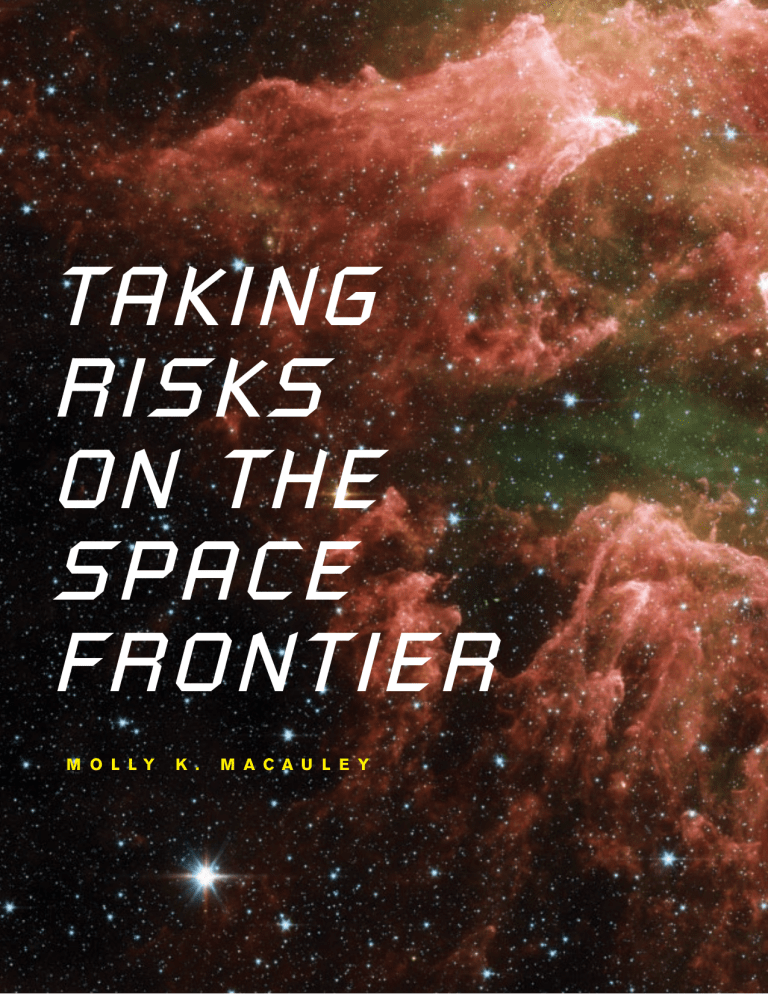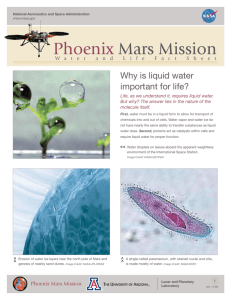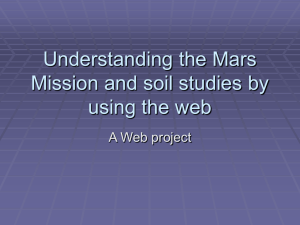T A K I N G R I S K S
advertisement

TAKING RISKS ON THE SPACE FRONTIER M O L LY K . M A C A U L E Y On January 14, 2004, President Bush announced a radically new direction for the U.S. space program. He directed NASA to return humans to the Moon by 2020 and later, send a manned mission to Mars. This vision has led NASA to prepare for the increasing role of humans in space — from developing new space transportation vehicles to modeling the potential short- and long-term medical effects of the harsh space environment.(At press time, the shuttle Discovery was carrying out its mission to restock the International Space Station.) Some months later, in summer 2004, the headlinemaking successful flight of SpaceShipOne heralded the first privately financed, commercial vehicle for taking ordinary citizens — not astronauts — to suborbital space and back. SpaceShipOne’s financial backers — affiliated with Virgin Atlantic Airlines — have promised to develop and promote routine space tourism in the near future. Their flight joins a list of two other flights since 2001 that took regular citizens commercially to space, with each space tourist paying Russia about $20 million to fly on the Soyuz rocket. In order to build a foundation for future analyses, Accompanying this significant infusion of public and private capital underwriting humans in space is a looming public policy problem: managing the risk. Risk is borne by the first parties — the actual space travelers themselves. Perhaps less obvious, risk is also borne by third parties, including persons on the ground beneath the flight path of a space vehicle and even the general public. Sound risk management calls for appropriate application, balancing, and coordination of regulation, legislation, and other forms of potential policy intervention. While government self-insures (that is, taxpayers underwrite the risk of NASA’s space activities), the increasingly large private-sector role in space also calls for greater consideration of the advantages and disadvantages of relying on conventional practices such as tort liability and insurance as alternatives to government intervention in designing public policy. In order to build a foundation for future analyses, it is important to note that zero risk in space activity is unattainable and an obviously unreasonable policy objective. The objective is not “no” risk but accepting risk; managing it through a combination of incentives, regulation, and legislation; and rationally deciding how much to accept based on the expected benefit. it is important to T H E H U M A N F A C T O R note that zero risk in space activity is unattainable and an obviously unreasonable policy objective. 26 The most notable examples of risks to humans involved in space activity are the fatal accidents that occurred with Apollo 1 and with the shuttles Challenger and Columbia. The policy response to these events is illustrative of as-yet-unresolved problems in risk management. After each incident, investigations by Congress, presidential commissions, and NASA itself led to engineering redesigns — in short, technological fixes. These reviews also recommended changes in how space activities are conducted, largely with respect to how safety concerns are communicated in large organizations like NASA. The history of these accidents repeatedly illustrates that spaceflight remains risky even after exhaustive, painstakingly detailed and careful investigation, extensive re-engineering, and changes in communication. Another pattern evident with these accidents is the extraordinarily long amount of time that has elapsed between each accident and subsequent return to flight. This trend harbors important implications for the degree to which the risk of flight might be more readily accepted. These long “stand-downs” after an accident will make it difficult for NASA to meet the timeline set forth in President Bush’s plan for sending humans to the moon by 2020. In the case of Apollo 1, the three-man crew of the Apollo command module died in a fire on the launch pad during a preflight test at Cape Canaveral on January 27, 1967. Twenty months elapsed before the next manned Apollo mission (an unmanned mission was flown in November 1967). First NASA and then Congress conducted exhaustive investigations of the accident. The reviews concluded that the most likely accident cause was a spark from a short circuit. Other factors materially contributed to the Apollo 1 accident, including the absence of emergency equipment or personnel on the launch pad because the test was a simulation and not considered hazardous, the lack of emergency exits or procedures for the crew, and problems that prevailed in communicating safety concerns between NASA and its contractors. The space shuttle Challenger accident on January 22, 1986, was attributable to flawed engineering design, poor management and accountability, and a host of oversights. The presidential commission investigating Challenger cited the cause of the disaster as a failure of an “O-ring” seal in one of the shuttle’s solid-fuel rockets. The commission found fault not only with the failed sealant ring but also with the NASA officials who allowed the shuttle launch to take place despite concerns voiced by engineers. RESOURCES The entire space shuttle program was grounded during the investigation and did not resume flying for 32 months — returning only after shuttle designers made several technical modifications and NASA management implemented stricter regulations regarding quality control and safety. The Columbia Accident Investigation Board (CAIB), established to investigate the February 1, 2003, accident cited physical failures in the spacecraft design and underlying weaknesses in NASA’s organization as the principal contributors to the incident. The physical cause was a breach in the thermal protection system on the wings. The organizational causes ranged from schedule pressures to characterization and management of the shuttle as operational rather than developmental. The CAIB said there was inadequate testing to fully understand the shuttle’s performance, organizational barriers that prevented effective communication about safety and stifled differences of opinion, and informal, poorly documented decisionmaking within the regular chain of command. The shuttle system resumed flying in July 2005 — about 18 months after the accident. In addition to its detailed review of the Columbia event, the CAIB offered a broader conclusion: “[O]peration of the Space Shuttle, and all human spaceflight, is a developmental activity with high inherent risks.” These words are worth bearing in mind, as future spacecraft that are developed to ferry humans to the moon and Mars will be radically new types of vehicles that must meet even more challenging flight conditions than did Apollo or the shuttles. The new spacecraft will need to be able to withstand extreme hot and cold, radiation, and longduration requirements that will be encountered on future missions. With each successive mission, vehicles are expected to evolve, with each stage incorporating increasingly more demanding physical capabilities. The program timing is likely to make each vehicle and each flight a unique experiment with new, unknown risks. Above: An artist's concept of a possible newfound planet spinning through a clearing, detected around the star CoKu Tau 4 by the Spitzer Space Telescope, in a nearby star's dusty, planetforming disc. The possible planet is theorized to be at least as massive as Jupiter, and may have a similar appearance to what the LEAVING IT UP TO ROBOTS Advances in computing and robotic technology since the Apollo and shuttle programs make unmanned exploration a potentially very close substitute for human exploration. Highresolution, high-speed, and high-quality animation and graphics of computerized virtual reality can readily be combined with the truly fantastic data sent back by unmanned probes. For those who want to see and even touch Mars, interplanetary robots can do this, too, by gathering samples and returning them to earth. Years ago, unmanned spacecraft brought back moon rocks. In 2004, a low-cost NASA spacecraft, Stardust, collected samples of comet and interplanetary dust and will return them to earth via parachute in 2006. Advances in unmanned data collection from space and other innovations in information technology are improving so rapidly that robotic success could even undo human exploration and enable sophisticated, “stay-at-home” explorers. Robots in the near future are likely to be capable of making split-second decisions and displaying the spirit of inquiry that human explorers bring. As the NASA probe Spirit began its journey on Mars, British scientists reported the first robot capable of theorizing, reasoning, and actively learning. SUMMER 2005 giant planets in our own solar system looked like billions of years ago. (NASA/JPL-Caltech/ R. Hurt; SSC-Caltech) Opening spread: Picture taken by NASA’s Spitzer Space Telescope, reveals a mix of embryonic stars in the Eta Carinae neighborhood of the Milky Way galaxy. (NASA/ JPL-Caltech/N. Smith; Univ. of Colorado at Boulder) 27 Balancing manned and robotic exploration based in part on a comparison of human risk is only part of a much larger and much-needed discussion about future space activities. brown dwarf surrounded by a While spaceflight accidents may never be taken in the stride of auto or aviation accidents, swirling disk of planet-building the pursuit of human spaceflight requires greater acceptance of the outcome that lives will dust. NASA’s Spitzer Space Telebe lost. According to NASA data, the number of fully qualified candidates for the astronaut scope spotted such a disk around corps has stayed the same or even increased after shuttle accidents, clear proof that applia surprisingly low-mass brown dwarf, or “failed star.” Astronomers cants are comfortable with their perceived level of the risks that come with manned space flight (see table on page 29). For policymakers, this finding can serve as a useful benchmark believe that this unusual system will eventually spawn planets. If so, in many policy decisions: when evaluating the trade-off between using robots or involving humans, in conducting accident reviews to ascertain “how safe is safe enough,” and in techthey speculate the disk has nological fixes for safer spacecraft. enough mass to make one small This artist's concept shows a gas giant and a few Earth-sized rocky planets. (NASA/JPL) F LY A T S O M E R I S K After the success of the privately built and financed spacecraft, SpaceShipOne, British businessman Richard Branson, who founded Virgin Atlantic Airlines, quickly entered into a licensing agreement with the owners to build five spacecraft for passengers. Branson’s business plan within the next three years is to fly 50 passengers a month, charging $200,000 each, for a two-hour flight. Shortly after the agreement, a hotel magnate offered another prize, for $50 million, for the first private manned mission to orbit the earth. 28 RESOURCES In the wake of SpaceShipOne’s success, the U.S. Congress entered into debate about how to regulate commercial human spaceflight, arguing at length about how to handle crew and passenger safety and the appropriate scope of authority to be vested with the government. Some legislators supported allowing privately owned and operated spacecraft to carry paying passengers on a “fly at your own risk” basis. This perspective made private spaceflight relatively free from regulation, much like the early aviation barnstorming era. As one expert opined, passengers should be able to board their vehicles with the same freedom as the stunt pilots who pioneered commercial aviation. Several draft bills before Congress proposed regulating the training and setting standards for the medical condition of crews, the extent to which passengers would have to be informed of the risks of their participation, and whether passengers would be required to supply written, informed consent to safety-related risk associated with the flight. Another topic of debate during the hearings was the use of mutual waivers of liability with licensees and the federal government as well as the extent of the government’s role. Industry wanted loose oversight, claiming that federal authority should be limited to safeguarding the uninvolved public (such as populations living under the flight path of the spacecraft). While the final version of the legislation for regulating space tourism has a preamble statement recognizing that space transportation is inherently risky, the specific provisions only loosely regulate passenger safety. The Commercial Space Launch Amendments Act of 2004 allows private spacecraft to be licensed on an experimental basis and establishes liability guidelines. The bill provides a legal basis for allowing private and commercial passengers to undertake space travel and establishes the concept of informed risk for space passengers. For the next eight years, the government can also restrict or prohibit design features or operating practices that have resulted in or could have contributed to a serious or fatal injury to crew or passengers during a licensed flight. This sunset provision is intended to allow safety standards to evolve in the industry and to permit revision of the standards. PLANETARY PROTECTION Yet another category of risk — potentially including risk to the population as a whole — looms ahead as humans play an ever-increasing role in space and particularly as we begin to bring samples back from robotic exploration of Mars in preparation for sending humans there. “Planetary protection” refers to two situations: protecting Earth from microorganisms that may be brought back in samples of soil, rocks, and other materials collected from other solar system bodies during scientific space exploration; and protecting the solar system — planets, moons, asteroids, and comets — from Earth life introduced when spacecraft land on or impact with these bodies. Contaminating other bodies is known as “forward contamination,” and contaminating Earth is known as “backward contamination.” Samples themselves can also become contaminated and must be collected and handled in a manner to protect them from terrestrial organisms in order to preserve their integrity. Planetary protection has long been a concern in space exploration. For example, to prevent backward contamination, the lunar samples collected by the Apollo astronauts as well as the astronauts themselves were quarantined upon return to earth. To prevent forward contamination, before launching the U.S. Viking missions to Mars in the 1970s, NASA cleaned the Mars landers to reduce bacterial spores on them, packaged the landers in a protective shield, and baked the packaged spacecraft to sterilize them. The rationale at that time was to avoid contamination in introducing life from earth into the Martian environment and thereby confounding analysis of the soils on the surface of Mars in looking for evidence of life. SUMMER 2005 Total Applications to Join Astronaut Corps and Number Selected 04/1959 508 7 09/1962 250 9 10/1963 720 14 06/1965 909 6 04/1966 510 19 08/1967 900 11 08/1969 * 7 07/1978 8079 35 07/1980 3465 19 07/1984 4934 17 08/1985 166 13 08/1987 2061 15 07/1990 2424 23 08/1992 2236 19 03/1995 2962 19 08/1996 2451 35 08/1998 2621 25 08/2000 3015 17 05/2004 2882 11 * Application data missing for 1969 Source: Aaron Manka et al. 2003. Improving Management of Astronaut Corps. June 27 Memo to Associate Administrator for Space Flight. G-01-035. (Data for 1959– 2003.) (www.hq.nasa.gov/office/ oig/hq/old/inspections_assessments /index .html, accessed July 2005); The Baltimore Sun. 2004. May 7, p.1b. (data for 2004). 29 Human risks associated with planetary contamination are wide ranging. They include risks to the general public when samples are returned to earth from space, risks to astronauts who may collect samples during space missions, risks to scientists and others who handle samples for analysis, and risks to life that may exist on other planets. NASA is now considering protocols for sample return and the appropriate design of laboratories where samples from Mars missions would be taken. The Space Studies Board of the National Research Council has recommended that laboratories housing Mars samples should match the strictest security requirement established by the U.S. government for facilities dealing with biological agents and infectious diseases. In another study, Safe on Mars: Precursor Measurements Necessary to Support Human Operations on the Martian Surface, the board points out the many environmental, chemical, and biological hazards involved in a human mission to Mars and some steps to take to mitigate these concerns. For example, dust on Mars could contain large amounts of sulfur, chlorine, and hexavalent chromium. LOOKING AHEAD International treaties and agreements, government safety regulation of space tourism and space transportation, and government indemnification of commercial space transportation currently exist for addressing some of the human risks in space activities. That said, however, many unresolved issues remain. If the lengthy stand-downs in spaceflight following the loss of life are to be the rule rather than the exception, human missions to the moon and Mars are light-years away. Because space activity will always be risky, unduly long delays are likely to be meaningless. In the early days of aviation, fatal accidents occurred almost routinely, but aviators flew again immediately. Provided those who fly — astronauts or passengers — give informed consent, and provided the financial consequences to the government or the private sector are acceptable, a return to the barnstormer approach to risk may make sense. Finally, robotic missions and the ability to return samples to earth — although not riskless — are increasingly viable alternatives to humans in space. Unless or until policymakers change their attitudes toward space-related risk, real change and the appropriate balance of humans and robots in space is not likely to come in the near future. ■ This article is drawn in part from “Flying in the Face of Uncertainty: Human Risk in Space Activities,” in the summer 2005 issue of the Chicago Journal of International Law. Discovery’s cargo bay over Earth’s Further Readings horizon was photographed by one Columbia Accident Investigation Board Report, executive summary at http://caib.nasa.gov (all sites accessed July 2005) Return to Flight report, executive summary at http://returntoflight.org Safe on Mars: Precursor Measurements Necessary to Support Human Operations on the Martian Surface. National Academy of Sciences Press, 2002, summary at www.nap.edu/catalog/103 60.html?onpi_newsdoc050102. of the seven crew members as the shuttle approached the International Space Station on July 28, 2005. (NASA) 30 RESOURCES






